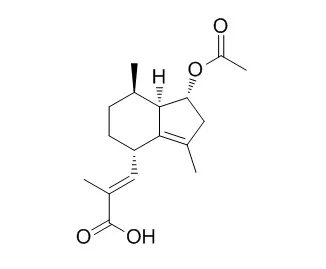| Animal Research: |
| Phytomedicine, 2012, 19(13):1216-1222. | | Valerian extract characterized by high valerenic acid and low acetoxy valerenic acid contents demonstrates anxiolytic activity.[Reference: WebLink] | Valerian is one of the most commonly used herbal remedies for the treatment of insomnia and anxiety. Valerian extracts allosterically modulate GABAA receptors, an action related to valerenic acid, which is one of the active compounds determined from pharmacological studies. Derivatives of valerenic acid, i.e. Acetoxyvalerenic acid or hydroxy valerenic acid, do not allosterically modulate GABAA receptors, but they bind to identical binding sites. Therefore, the question arises whether they might interfere with the effects of valerenic acid.
METHODS AND RESULTS:
Two valerian extracts were tested in the elevated plus maze test and the tail suspension test for anxiolytic and antidepressive activity, respectively. Reference substances were diazepam (1.0 mg/kg) and imipramine (30 mg/kg). The extracts were standardized to the identical total amounts of the acids (0.1; 0.5; 1.0 and 2.0 mg/kg), i.e. valerenic and Acetoxyvalerenic acid, but the ratio between the acids was different (12:1 and 1:1.5). The extract with the ratio 12:1 prolonged the time spent on the open arm significantly when 0.5 mg/kg was applied. Of the other extract, with the ratio 1:1.5, four times that amount was required (2.0 mg/kg). Both of the tested extracts did not show any antidepressive effect, rather the other way around, the extract with the ratio 1:1.5 prolonged the immobility phase. However, since the core body temperature was reduced by the 1.0 and 2.0 mg/kg extract dose, the prolongation may be related to the temperature phenomenon and is not indicative of a specific depressive action.
CONCLUSIONS:
In conclusion, the anxiolytic activity of the valerian extract seems rather related to valerenic acid and, moreover, standardization with respect to the total amount of valerenic acids, i.e. valerenic acid together with acetoxy valerenic acid, is misleading. |
|
| Structure Identification: |
| Die pharmazie, 2004, 59(9):727-8. | | Extraction of valerenic acids from valerian (Valeriana officinalis L.) rhizomes.[Reference: WebLink] | Extraction of valerenic acids (valerenic, acetoxyvalerenic and hydroxyvalerenic) from dry ground rhizomes of valerian (Valeriana officinalis L.) was studied.
METHODS AND RESULTS:
The effect of ethanol concentration in the solvent, extraction temperature and drug particle size on extraction kinetics were investigated and the optimum values of these process parameters were determined for the case of intensively stirred two-phase dispersion.
CONCLUSIONS:
It was found that increased processing temperature favors extraction kinetics, but provokes moderate degradation of valerenic acids. |
|






 Cell. 2018 Jan 11;172(1-2):249-261.e12. doi: 10.1016/j.cell.2017.12.019.IF=36.216(2019)
Cell. 2018 Jan 11;172(1-2):249-261.e12. doi: 10.1016/j.cell.2017.12.019.IF=36.216(2019) Cell Metab. 2020 Mar 3;31(3):534-548.e5. doi: 10.1016/j.cmet.2020.01.002.IF=22.415(2019)
Cell Metab. 2020 Mar 3;31(3):534-548.e5. doi: 10.1016/j.cmet.2020.01.002.IF=22.415(2019) Mol Cell. 2017 Nov 16;68(4):673-685.e6. doi: 10.1016/j.molcel.2017.10.022.IF=14.548(2019)
Mol Cell. 2017 Nov 16;68(4):673-685.e6. doi: 10.1016/j.molcel.2017.10.022.IF=14.548(2019)